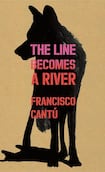
Opening the pages of The Line Becomes A River is like entering a new world, a place where the landscape is scarred by death and destruction and the smell of fear hangs heavy in the air.
Francisco Cantu’s debut is set along the US-Mexican border in southern Texas, a place that has taken on renewed focus since the election of Donald Trump who swept to power on the promise of building his fabled wall.
Cantu, a third-generation Mexican-American and former Fulbright scholar, was already a respected writer and essayist. This book recounts his experience working for the United States Border Patrol from 2008 and 2012. As he tells his mother, who passed on the love of the land to her son through her own work as a National Park ranger, he is “tired of reading about the border in books”. Instead he wants to live and work at the border. “I’ll never understand it until I’m close to it.”

What follows is an account of his experience as part of the US immigration machinery and his persistent impulse to return to the borderland and the people who traverse it, long after he has left the patrol.
Cantu describes in chilling detail the work of the border control guards whose job it is to scour the arid, vast terrain of the southern United States for illegal immigrants.
It is a landscape scattered with the detritus of the hopeful migrants and the people smugglers who control them, a landscape “full of old blankets and discarded clothes and pieces of twine and empty cans of tuna and crushed water bottles”. He comes across rotting bodies and half-dead migrants, who he rounds-up under the blistering heat and escorts to the processing centre to await a court hearing and deportation.
The book is interpolated by anecdotes of individuals – the four men who had wandered in the desert 50 miles north of the border for 48 hours without food or water, one who was unable to remember his name, a couple he finds huddled together in a church in front of an image of the Virgin of Guadalupe, and a woman who has been abandoned by her smugglers while she was trying to reach her husband in Phoenix and thanks Cantu as he bathes and dresses her broken feet.
Part memoir, part history, this book evokes the barren expanse of the desert in all its grandeur and hostility. At times it as if we have entered a Hades-like lunar topography, as the border becomes a disputed territory between heaven and hell, conscious and unconscious, sanity and madness.
The narrative voice throughout the book is consistently restrained, unnervingly clinical. It is as if the controlled style reflects Cantu’s own numbness as his mental health begins to suffer and he confronts his “fear of coming unravelled” as he is plagued by hellish nightmares.
As Cantu tries to make sense of the reality unfolding around him, he draws on previous works including Ed Vulliamy's ground-breaking book on the illegal drug trade Amexica, writer Cristina Rivera Garza's reflections on the pervasiveness of pain in Mexican society, and the work of psychologist Carl Jung.
Weaving these works into the book adds much-needed context to the current debate about immigration, and the specific history of the US-Mexican border.
Cantu juxtaposes his own personal narrative with a reminder of the horrors of recent and ongoing violence in Mexico and the borderlands – the prevalence of the drug cartels, and the extreme violence and gruesome dismemberment that characterise their killings. The book recounts specific cases, such as the femicide epidemic that swept the city of Ciudad Juarez which saw countless women kidnapped and murdered, and the abduction and massacre of 43 trainee teachers from a school in Ayotzinapa in 2014, a crime that remains unsolved.
At a time of acute debate about immigration policy in the United States and Donald Trump's promise to build a border wall with Mexico, The Line Becomes a River is a timely contribution to the immigration debate.
By shedding a light on the mechanics of border patrolling, and giving a voice to the many Mexicans and Americans of Mexican descent, the book examines the challenges of policing “the people who share our neighbourhoods, our cities, our country, our borders, our intractably and intimately interwoven global community”.
Ultimately, however, The Line Becomes A River shows the limits of the individual in the face of a labyrinthine political and bureaucratic system. As Cantu strives to connect with some of the migrants trapped in the immigration machine, the futility of his actions is laid bare. As he reflects on his friend Jose towards the end of the book: "[HIS] position is not unique. There are thousands of people just like him, thousands of cases, thousands of families. Millions actually – the whole idea of it is suffocating."














